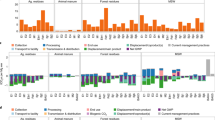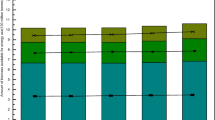Abstract
Declining grassland management in the Austrian Alps demands alternative usage strategies for unused biomass. This case study suggests biogas production as a suitable solution. The study employs a novel calculation scheme to calculate the biogas potentials of grassland and agro-municipal wastes in two model regions. In economic terms, model region one relies heavily on winter and summer tourism with few agricultural operations. Model region two has less intensive tourism and a more prevalent agricultural sector. Using a linear regression model, changes in animal stocks, biogas yields, and energy production were calculated for 2010, 2020, and 2030. Results showed that in 2010, model region one had 1186 t dry matter (DM) a−1 unused grassland biomass, which, combined with other agro-municipal wastes, could have produced 524,580 Nm3 a−1 of methane. Combusting this amount of methane in a CHP would result in 2 GWhel a−1 and 2.2 GWhth a−1. Similarly, including wastes and 557 t DM a−1 unused grassland biomass, model region two could have produced 1,305,892 Nm3 a−1 methane and 4.9 GWhel a−1 and 5.5 GWhth a−1. By 2030, unused grassland biomass is predicted to increase in both regions. Including other organic and agricultural residues, the total methane potential for region one will be 575,784 Nm3 a−1 (+9 %) and 1,769,471 Nm3 a−1 (+36 %) in region two by 2030.
Similar content being viewed by others
References
Pötsch EM (2009) Multifunktionalität und Bewirtschaftungsvielfalt im österreichischen Grünland. Ländlicher Raum: Oline-Journal Austrian Federal Ministry of Agriculture, Forestry, Environment and Water Management 1–22
Bouamra-Mechemache Z, Jongeneel R, Réquillart V (2009) EU dairy policy reforms: Luxembourg reform, WTO negotiations and the quota regime. EuroChoices 8(1):13–22. doi:10.1111/j.1746-692X.2009.00117.x
Buchgraber K (2004) Energetisch und stofflich nutzbare Biomasse aus dem österreichischen Grünland. Biogasproduktion—alternative Biomassenutzung und Energiegewinnung in der Landwirtschaft, 10. Alpenländisches Expertenforum edn. BAL, Irdning
OECD, FAO (2010) OECD-FAO Agricultural-Outlook 2010–2019. Organisation for Economic Co-Operation and Development—Food and Agriculture Organization of the United Nations. Paris, 251 pp
Kempen M, Witzke P, Pérez Domínguez I, Jansson T, Sckokai P (2011) Economic and environmental impacts of milk quota reform in Europe. J Policy Model 3(1):29–52. doi:10.1016/j.jpolmod.2010.10.007
Austrian Federal Ministry of Agriculture, Forestry, Environment and Water Management (2013) Grüner Bericht 2013. Bericht über die Situation der österreichischen Land− und Forstwirtschaft. Vienna
German Federal Ministry for the Environment, Nature Conservation, Building and Nuclear Safety (2007) Climate Change in the Alps. Facts—Impacts—Adaptation. Berlin, 95 pp
Fuhrer J, Calanca P, Deila C, Forrer H-R, Lehmann B, Luder W, Müller-Ferch G, Münger A, Sonnevelt M, Uebersax A (2007) Klimaänderung und die Schweiz 2050. Erwartete Auswirkungen auf Umwelt, Gesellschaft und Wirtschaft. In: OcCc/ProClim (ed). OcCC/ProClim-, Bern, pp 41–52
Bauer A, Lizasoain J, Theuretzbacher F, Agger JW, Rincón M, Menardo S, Saylor MK, Enguídanos R, Nielsen PJ, Gronauer A, Horn SJ (2014) Steam explosion pretreatment for enhancing biogas production of late harvested hay. Bioresour Technol 166:403–410. doi:10.1016/j.biortech.2014.05.025
Pérez-Elvira SI, Fdz-Polanco F (2012) Continuous thermal hydrolysis and anaerobic digestion of sludge. Energy integration study. Water Sci Technol J Int Assoc Water Pollut Res 65(10):1839–1846. doi:10.2166/wst.2012.863
Sargalski W, Solheim OE, Fjordside C (2007) Treating Organic Waste with CAMBI ® THP. Paper presented at the 12th European Biosolids and Organic Resources Conference. November 2007, Manchester
Prochnow A, Heiermann M, Plöchl M, Linke B, Idler C, Amon T, Hobbs PJ (2009) Bioenergy from permanent grassland− A review: 1. Biogas. Bioresour Technol 100(21):4931–4944. doi:10.1016/j.biortech.2009.05.070
Li A, Antizar-Ladislao B, Khraisheh M (2007) Bioconversion of municipal solid waste to glucose for bio-ethanol production. Bioprocess Biosyst Eng 30(3):189–196. doi:10.1007/s00449-007-0114-3
Ballesteros I, Oli JM, Negro MJ, Manzanares P, Ballesteros M (2002) Enzymic hydrolysis of steam exploded herbaceous agricultural waste (Brassica carinata) at different particule sizes. Process Biochem 38:187–192. doi:10.1016/S0032-9592(02)00070-5
Bauer A, Bösch P, Friedl A, Amon T (2009) Analysis of methane potentials of steam-exploded wheat straw and estimation of energy yields of combined ethanol and methane production. J Biotechnol 142(1):50–55. doi:10.1016/j.jbiotec.2009.01.017
Ohgren K, Rudolf A, Galbe M, Zacchi G (2006) Fuel ethanol production from steam-pretreated corn stover using SSF at higher dry matter content. Biomass Bioenergy 30(10):863–869. doi:10.1016/j.biombioe.2006.02.002
De Paoli F, Bauer A, Leonhartsberger C, Amon B, Amon T (2011) Utilization of by-products from ethanol production as substrate for biogas production. Bioresour Technol 102(11):6621–6624. doi:10.1016/j.biortech.2011.03.045
Horn SJ, Estevez MM, Nielsen HK, Linjordet R, Eijsink VGH (2011) Biogas production and saccharification of Salix pretreated at different steam explosion conditions. Bioresour Technol 102(17):7932–7936. doi:10.1016/j.biortech.2011.06.042
Statistik Austria (2012) Abgestimmte Erwerbsstatistik 2010. http://www.statistik.at/blickgem/ae1/g80113.pdf. Accessed 7 June 2013
Statistik Austria (2014) Agrarstrukturerhebung 2010. STATcube—Statistische Datenbank. http://www.statistik.at/web_de/services/datenbank_superstar/. Accessed 5 January 2013
Austrian Federal Ministry of Agriculture, Forestry, Environment and Water Management (2006) Richtlinien für die Sachgerechte Düngung. Anleitung zur Interpretation von Bodenuntersuchungsergebnissen in der Landwirtschaft. Bundesministerium für Land− und Forstwirtschaft, Umwelt und Wasserwirtschaft, Vienna
Kaltschmitt M, Wiese A (1993) Erneuerbare energieträger in Deutschland. Potentiale und kosten. Springer-Verlag, Berlin
Buchgraber K (2000) Ertragspotentiale und Artenvielfalt auf Grünlandstandorten im Berggebiet; MAB-Forschungsbericht: Landschaft und Landwirtschaft im Wandel, Austrian Academy of Sciences, 22–23 September 2000, Vienna, pp 181–189
Döhler H, Eckel H, Fröba N, Grebe S, Hartmann S, Häußermann U, Klages S, Sauer N, Nakazi S, Niebaum A, Roth U, Wirth B, Wulf S, KTBL—Kuratorium für Technik und Bauwesen in der Landwirtschaft e.V. (Hrsg.): Faustzahlen Biogas. 2. Auflage. Darmstadt: KTBL, 2009 ISBN 978-3-941283-28-3
Johann Heinrich von Thünen-Institut (2009) Biogas-Messprogramm II. 61 Biogasanlagen im Vergleich. Fachagentur Nachwachsende Rohstoffe e.V. (FNR) edn., Gülzow
Effenberger M, Bachmaier H, Kränsel E, Lehner A, Gronauer A (2009) Wissenschaftliche Begleitung der Pilotbetriebe zur Biogasproduktion in Bayern, Abschlussbericht, Schriftenreihe der Bayerische Landesanstalt für Landwirtschaft (LfL), ISSN 161–4159, Freising-Weihenstephan, Germany
Bavarian State Research Center for Agriculture (n.d.), http://www.lfl.bayern.de/iab/duengung/mineralisch/10536/bas13_internet.pdf. Accessed 18 March 2013
Bavarian State Research Center for Agriculture (2011) Nutzung von Grünland zur Biogaserzeugung. Machbarkeitsstudie. Final Report. Freising-Weihenstephan
Steiger R, Abegg B (2013) The sensitivity of Austrian Ski areas to climate change. Tour Plan Dev 10(4):480–493. doi:10.1080/21568316.2013.804431
Buchgraber K, Resch R, Blaschka A (2003) Entwicklung, Produktivität und Perspektiven der österreichischen Grünlandwirtschaft, 9. Alpenländisches Expertenforum, 27.–28. März 2003, BAL Gumpenstein: Das österreichische Berggrünland—ein aktueller Situationsbericht mit Blick in die Zukunft (conference proceeding): 9–18
Frantál B, Kunc J (2011) Wind turbines in tourism landscapes. Ann Tour Res 38(2):499–519. doi:10.1016/j.annals.2010.10.007
NFO World Group (2003) Investigation into the Potential Impact of Wind Farms on Tourism in Wales. Edinburgh, pp 1–21. http://www.ecodyfi.org.uk/tourism/Windfarms_research_eng.pdf/. Accessed 24 February 2015
Pröbstl U, Jiricka A, Hindinger F (2011) Renewable energy in winter sports destinations—desired, ignored or rejected? In: Borsdorf A, Stötter J, Veulliet E (eds) Managing Alpine Future II “Inspire and drive sustainable mountain regions” Proceedings of the Innsbruck Conference, November 21–23, 2011, Innsbruck, ate 2011. Austrian Academy of Sciences Press
Prochnow A, Heiermann M, Plöchl M, Amon T, Hobbs PJ (2009) Bioenergy from permanent grassland− A review: 2. Combust Bioresour Technol 100(21):4945–4954. doi:10.1016/j.biortech.2009.05.069
Rösch C, Raab K, Skarka J, Stelzer V (2007) Energie aus dem Grünland—eine nachhaltige Entwicklung? Forschungszentrum Karlsruhe (Wissenschaftliche Berichte, FZKA 7333), Karlsruhe
Bavarian State Research Center for Agriculture (s.a.) Biogasausbeuten verschiedener Substrate. http://www.lfl.bayern.de/iba/energie/049711/. Accessed 26 April 2013
Panter K, Solheim OE, Fjordside C (2004) Hydrolysis and Digestion of Biodegradable Municipal Waste at Lillehammer, Norway—2 Years Full Scale Experience. CIWM, September 2004, UK
Acknowledgments
This project was carried out by the alpS—Centre for Climate Change Adaptation. The program of Competence Centers for Excellent Technologies (COMET) is an initiative of the Federal Ministry of Transport, Innovation and Technology and the Federal Ministry of Science, Research and Economy. Additional support for the program came from the federal states of Tyrol and Vorarlberg. The COMET program will be carried by the Austrian Research Promotion Agency (FFG).
Author information
Authors and Affiliations
Corresponding author
Rights and permissions
About this article
Cite this article
Frühauf, S., Saylor, M.K., Lizasoain, J. et al. Potential Analysis of Agro-Municipal Residues as a Source of Renewable Energy. Bioenerg. Res. 8, 1449–1456 (2015). https://doi.org/10.1007/s12155-015-9608-z
Published:
Issue Date:
DOI: https://doi.org/10.1007/s12155-015-9608-z




